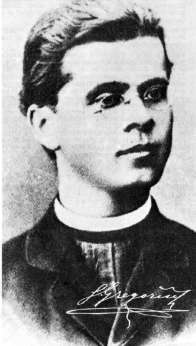The directory «Plots»
Gregorčič Simon
(1844—1906)

Simon Gregorčič is most popular poet and the first artistic narrator of the area of Tolmin and Gorica. He was born one hundred and fifty years ago (on October 15, 1844) in Vrsno, a small village above Kobarid, amid the mountains dominated by the mighty Krn. After receiving a modest education in his home parish of Libušnje, his parents sent him to Gorica where he continued his schooling until he was ordained priest. He made a rather heavy-hearted decision to become a clergyman because he wanted to study classical philology in Vienna, but was thwarted in his designs by poverty. He began writing poetry as early as in his grammar school years, and in 1864 he published in Janežič's "Slovenski glasnik" (The Slovenian Herald) in Klagenfurt his first patriotic verses, which were gathered in a cycle under the title "Iskrice domorodne" (Patriotic Sparkles). Following the model of Prešeren and Junk, in this cycle he revealed his patriotic feelings, especially his love towards his oppressed people and its Slavic brothers.
From the posts where he served as a curate, which were all in the area of Gorica (Kobarid, Branik-Rihemberk, Gradišče pri Prvačini) he was sending his poems to Vienna where they were published in the "Zvon magazine". The magazine's editor and publisher Josip Stritar not only made possible the publication of his poems but he also encouraged him and offered his additional instructions on poetry, making him a poet much to his own likeness. Gregorčič signed his poems with a humble "X" and it was not before 1882 that he had them printed under his full name in the volume entitled "Poezije" (Poems). The book immediately aroused much enthusiasm as well as indignation. Fran Levec, the editor of "Ljubljanski zvon" a literary magazine of that time, declared it a "golden book", whereas Anton Mahnič, a theology professor from Gorica, condemned it as scandalous. Yet the real success and significance of this collection of poetry was condemned by the fact that the book was quickly sold out to amateurs of his poems. The two later collections of his poems, however, proved less successful. Weary and suffering from a heart condition, the poet soon abandoned priesthood and until 1903 lived as a pensioner and "poet-farmer" in Gradišče, whereupon he moved to Gorica where he died on November 24, 1906.
Especially popular among the simple reading public were his patriotic poems with mountain-related subjects like "Pastir" (The Shepherd), "Veseli pastir" (The Merry Shepherd), "Nazaj v planinski raj" (Back to the Mountain Paradise), "Soči", (To The Soča) and those with a pronounced social patriotic thought like the parable "V pepelnični noči" (On Ash Wednesday Night). Others preferred Gregorčič's lyrics with hidden erotic subjects: "Izgubljeni cvet" (The Lost Flower), "V krčmi" (At the Inn), "Njega ni" (He Has Not Come), "Ohrani Bog te v cvetu" (May the Lord Preserve you in Your Prime), etc.
In addition to this kind of poetry, more demanding educated readers also highly appreciated poems about the man's tragic destiny and his wavering between hope and despair ("človeka nikar" - Spare the Man; "Ujetega ptiča tožba" - A Captive Bird's Complaint; "Moj črni plašč" - My Black Coat) and his epics ("Jeftejeva prisega" Jeftej's Oath; "Hajdukova oporoka" - The Hajduk's Last Will).
Simon Gregorčič is undoubtedly most important lyrist in the period between the time of Junk and the Slovene Modernism; with his emotionally vivid and melodious poetry he has justly been attributed the honorary title of the "nightingale of Gorica"
His countrymen paid tribute to him on his funeral, which the then emerging new poet of Primorsko, Alojz Gradnik remembered by its splendour as the most remarkable experience of his youth. They later also took great care of his tomb and the house in which he was born, which were especially hard hit during World War I, when the poet's prophecy about "landgrabbing strangers" came true. Today, when his native land is free of foreign domination, visitors are attracted by his house, which has in the meantime been transformed into a museum, and his tomb atop the hill of St. Lawrence, which rises above the crystal-clear Soča.
Slovenia, 1994, Nightingale of Gorica
Yugoslavia, 1957, Simon Gregorčič
Slovenia, 1994.01.14,  Nova Gorica. Simon Gregorčič
Nova Gorica. Simon Gregorčič